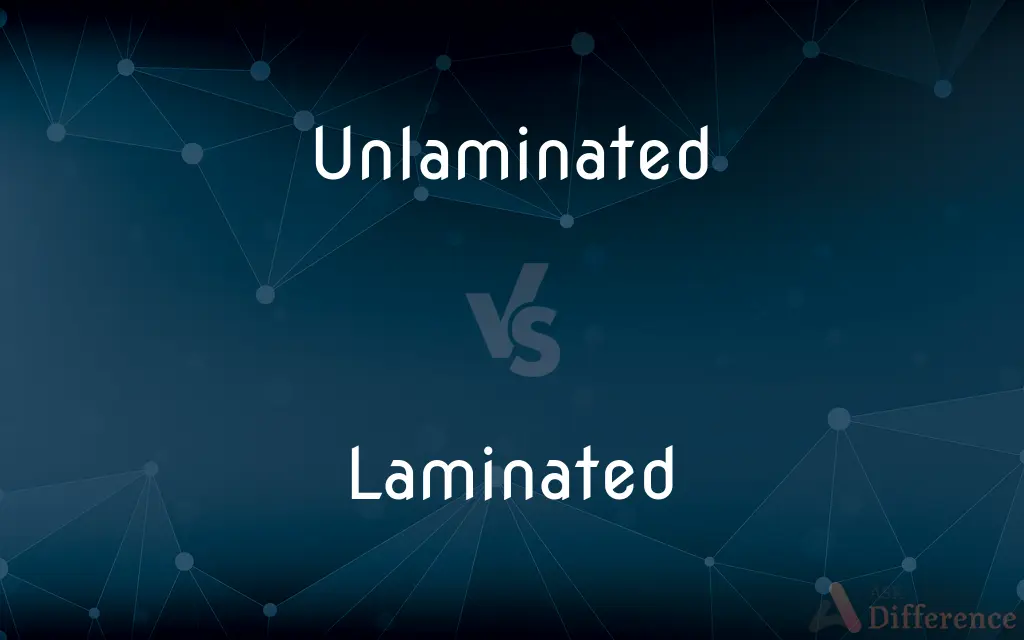Unlaminated vs. Laminated — What's the Difference?
By Maham Liaqat & Fiza Rafique — Updated on April 24, 2024
Unlaminated materials lack a protective film, exposing them to wear and environmental factors, while laminated materials are coated with a clear or matte plastic layer, enhancing durability and resistance.

Difference Between Unlaminated and Laminated
Table of Contents
ADVERTISEMENT
Key Differences
Unlaminated items are typically more vulnerable to damage such as tearing, moisture, and fading due to exposure to environmental elements. On the other hand, laminated items have a protective plastic coating that shields them from such damage, thereby extending their lifespan.
The cost of production for unlaminated materials is usually lower, making them more economical for short-term use or disposable items. Laminated materials, however, involve additional processing and materials, which increase the cost but offer better longevity and quality.
Unlaminated products often have a more natural texture, which can be important for items like art prints or certain types of packaging that benefit from an organic look and feel. In contrast, laminated products have a glossy or matte finish that can enhance visual appeal and tactile experience, but may detract from a natural appearance.
When it comes to recycling, unlaminated paper products are easier to process and recycle than laminated ones, which often require special facilities to separate the plastic from other materials. This makes unlaminated materials more environmentally friendly in contexts where disposability and recycling are priorities.
In terms of flexibility and customization, unlaminated materials are generally easier to handle and modify. They can be cut, folded, or manipulated without much difficulty. Laminated materials, while more durable, are stiffer and can be more challenging to alter once the lamination process is complete.
ADVERTISEMENT
Comparison Chart
Durability
Less durable, prone to environmental wear
Highly durable, protected against wear and tear
Cost
Lower cost due to simpler production
Higher cost due to additional lamination process
Texture and Appearance
Natural texture and appearance
Glossy or matte finish, often more visually striking
Environmental Impact
Easier to recycle, more eco-friendly
Difficult to recycle, less eco-friendly
Flexibility
More flexible, easy to manipulate
Less flexible, harder to alter post-production
Compare with Definitions
Unlaminated
Not covered with a protective film.
The unlaminated document quickly became dog-eared from frequent handling.
Laminated
Covered with a layer of protective plastic.
The laminated map resisted tears and water damage during the hike.
Unlaminated
Exposed to natural elements without protection.
The unlaminated sign faded under the summer sun.
Laminated
Costs more due to additional materials and processing.
The laminated book covers were more expensive but lasted longer in the school library.
Unlaminated
Simpler and more natural in appearance.
The unlaminated wood in the furniture showcased its natural grain.
Laminated
Typically featuring a glossy or matte finish.
The laminated photographs had a glossy finish that made the colors pop.
Unlaminated
Easier to recycle due to absence of synthetic coatings.
The unlaminated papers were easily processed in the recycling plant.
Laminated
Enhanced for durability and resistance to external factors.
The laminated flooring was ideal for the high-traffic area.
Unlaminated
Generally less costly due to simpler production processes.
Choosing unlaminated business cards reduced the printing costs.
Laminated
Difficult to recycle due to mixed materials.
The laminated packaging required special processing to separate the plastic.
Unlaminated
Not laminated.
Laminated
Composed of layers bonded together.
Laminated
Arranged in laminae; laminate.
Laminated
Made by lamination.
Laminated
Consisting of many thin layers.
A laminated arch is a timber arch made of layers of bent planks secured by treenails.
Laminated
Splitting into thin layers parallel to bedding.
Shale is laminated.
Laminated
Simple past tense and past participle of laminate
Laminated
Consisting of, or covered with, laminae, or thin plates, sheets, scales, or layers, one over another; laminate.
Laminated
Constructed of thin sheets of material, bonded together to form a composite structure having multiple layers.
Common Curiosities
Can laminated items be recycled?
Recycling laminated items is challenging due to the plastic layer, often requiring special facilities to separate materials.
Are unlaminated materials less durable?
Yes, unlaminated materials are generally less durable as they lack the protective film that shields against environmental damage.
What types of materials can be laminated?
Paper, photographs, ID cards, menus, and many other materials can be laminated to protect them from damage.
How does lamination affect the appearance of materials?
Lamination adds a glossy or matte finish that can enhance visual appeal, though it may alter the natural texture of the material.
What are the primary benefits of lamination?
Lamination protects materials from wear, moisture, and fading, enhancing durability and maintaining appearance over time.
What is the environmental impact of lamination?
The environmental impact is greater with laminated materials, as they are harder to recycle and degrade.
Is lamination expensive?
Lamination incurs additional costs due to the materials and process involved, making laminated products more expensive than their unlaminated counterparts.
Why choose unlaminated products?
Unlaminated products are more economical and environmentally friendly, suitable for short-term use and easier recycling.
Is there a preference for using laminated items in certain industries?
Yes, industries that require durable, moisture-resistant, and frequently handled materials, like food services and education, often prefer laminated items.
Can any material be laminated?
While many materials can be laminated, not all are suitable due to heat sensitivity or other factors that might be affected by the lamination process.
Share Your Discovery

Previous Comparison
Peplos vs. Chiton
Next Comparison
Christmas vs. XmasAuthor Spotlight
Written by
Maham LiaqatCo-written by
Fiza RafiqueFiza Rafique is a skilled content writer at AskDifference.com, where she meticulously refines and enhances written pieces. Drawing from her vast editorial expertise, Fiza ensures clarity, accuracy, and precision in every article. Passionate about language, she continually seeks to elevate the quality of content for readers worldwide.














































